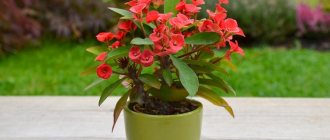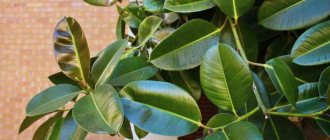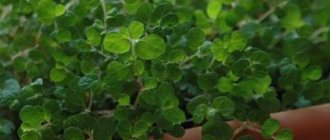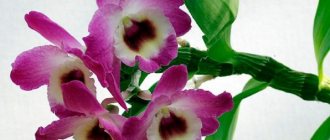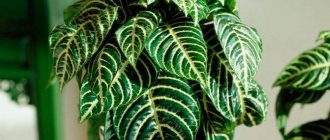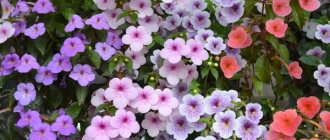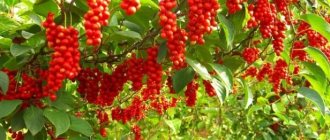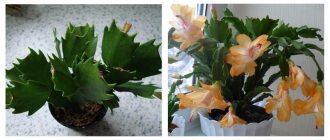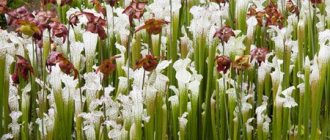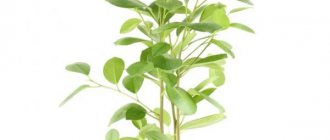Inexperienced flower growers, meeting this plant for the first time, may not recognize it as a ficus, but few of them will refuse to see it on their windowsill. Ficus Ali (Alii or Ficus Binnendijkii) is an evergreen tree of the Mulberry family. It grows naturally in Asian countries. Among all the varieties of the genus, it is the one most often chosen for landscaping residential premises and offices.
Appearance and varieties
Under the names “Ficus Ali” or “Ficus Binnendijka” there is a whole group of plants that look similar to each other. In the 19th century, they were discovered and described by the Dutch gardener and botanist Simon Binnendijk. "Nakhodka" was subsequently named in his honor, and the name was later simplified colloquially to "Binnedick Ali", "Benedict Ali" and "Binnendick". That is, to be more specific, Ali is a miniature indoor variety of a huge willow tree brought to Europe from the Asian tropics. Sometimes it is mistakenly considered a variety of Ficus Benjamin, but as is easy to see from its appearance, these are different plants.
The most popular domesticated varieties (cultivars) of ficus Binnendieck are:
- Ficus Ali (Ficus Binnendijkii cv. Alii). Differs in leaves that are slightly wider than those of Ficus Binnendijkii. The most cultivated variety at home among all other Bennendickians.
Ficus Binnendijkii Alii
- Ficus Ali Amstel Green Gold (Ficus Binnendijkii cv. Amstel Green Gold). The narrow leaves of this variegated variety have a very beautiful and original color: on a yellow-green background, spots of different configurations and different shades of green are randomly located. This cultivar is sometimes also called “Variegata” (syn. Ficus binnendijkii Variegata).
Ficus Binnendijkii Amstel Green Gold
- Ficus Amstel King (Ficus Binnendijkii cv. Amstel King). Large-leaved variety. The width of its leaves is up to 7 cm.
Ficus Binnendijkii Amstel King
- Ficus Amstel Queen (Ficus Binnendijkii cv. Amstel Queen). The leaves of this exotic are slightly wider than those of Ali, but narrower than those of Amstel King. The bark may take on a reddish tint.
Ficus Binnendijkii Amstel Queen
In their natural habitat, in the tropical forests of Southeast Asia, Binnendijk ficuses are evergreen trees that grow up to 15-20 meters. In indoor conditions, these are small trees, the height of which is rarely higher than 2 meters. Their bark is smooth, with white streaks; in young specimens it is dark brown, in adults it is white-gray.
If we talk about how this ficus blooms, then it should be noted that it is very difficult to achieve its flowering at home. There are not enough pollinating insects to set seeds. In nature, it is observed every spring. The flowers themselves, which can be male or female, do not look like a flower in the usual sense. They look like growths on the bark.
The main reason for the difficulties that you may encounter when identifying a variety is the unusual shape of the leaves. In Ficus Ali they are long (up to 30 cm in length) and narrow (5-7 cm in width), reminiscent of willow leaves, which is why people often call it “ficus willow”. The color of the foliage depends on the variety and its habitat and can be variegated (variegated) or monochromatic. Veins run through the center, refracting the leaves in the middle, so that in appearance they resemble open pea pods. The green mass is very thick, so the branches sink downwards under its weight, as if they were “crying”.
Main varieties
Ficus Binnendijka has many derived varieties. They are all unique in their own way.
Today we will consider only the most popular among gardeners .
Ficus ali
More often than others you can find it in interior design . Its leaf blades have slight differences from other varieties due to the slightly increased leaf width. This gives the ficus a certain grace, which is readily used by breeders to decorate the facades of buildings and premises;
Amstel king
It has advantages due to its ease of care . Original in appearance. The leaves can reach 8 cm in width. Slightly wavy and shiny. A young plant has a soft brown bark , while an adult has silvery bark;
Amstel gold
It is also called “green gold”. The name itself calls for the acquisition of this particular owner of an incredibly rich gilded color . The leaf blades have an unusual and very beautiful color, which suggests the presence of green-yellow pigmentation at the base of each leaf.
And its entire surface is covered with multiple inclusions of shades of green of various shapes . An unusual and elegant decoration for any room;
Amstel Queen
A variety with an intermediate width of the leaf blade, the owner of an incredible and noble color. This ficus is amazing in its magnificence . It will bring color to the interior and become a unique decoration.
Ficus Ali: reproduction
At home, Ficus Binnendijka is propagated by stem cuttings. Propagation material is best collected from an adult tree in spring and summer. Before propagating Ficus Ali - using a sharp knife or pruning shears to cut 15-20 cm long cuttings from the stems of the mother plant, you need to prepare water and a container for their rooting.
The water should be settled and heated to room temperature. Any container will do, it can be a glass jar or a plastic container. The cuttings are placed in a container with water and kept in a warm room at an air temperature of 20-25 degrees, away from direct sunlight. If the room is too hot, the cuttings are sprayed with water at room temperature from a spray bottle from time to time. Water is periodically added to the container. After 1-2 weeks, the cuttings produce roots. After 3-4 weeks, when the roots reach 2-2.5 centimeters, the cuttings are planted in the soil.
Ficus trees can also be propagated by seeds. Such seeds are sold in many specialized stores. This is not the most popular method as it requires a lot of time and patience.
Ficus lyrata F. Lirata
The species received its name for the resemblance of large wavy leaves to a lyre. Against a dark background, the foliage has raised light veins. The leaf can grow up to 50 cm, so the plant has impressive dimensions and requires a lot of space, but at the same time does not tolerate proximity to other flowers.
Loves diffused bright light and moderate temperature. During the dormant period (winter) – keep it cool at a temperature of 12-15°. Warm water is used for irrigation. The soil should not be constantly wet. Requires drying between waterings. In spring, summer and autumn, fertilizing with mineral fertilizers is necessary 2 times a month. In summer, it is advisable to spray the leaves and wipe them with a damp sponge. The flower is replanted when the pot is completely filled with the root system.
Known varieties of ficus lyreate:
- Columnaris - a tall variety, suitable for offices, clubs, restaurants, requires a lot of space, fast growing;
- Little Fiddle is a medium-sized plant, suitable for spacious living rooms;
- Bambino - fits perfectly into a small apartment, as it has compact dimensions.
Features of care
This exotic green pet is not at all capricious to care for at home, it grows very quickly and can hit the ceiling just a couple of years after rooting. In order for a tree to captivate others with its well-groomed appearance, it is enough to create certain conditions for it.
The soil
The soil for ficus willow must be fertile, loose, breathable, and not retain excess moisture. Alkaline and acidic soil types are not suitable. Cuttings can be planted in ready-made soils for palm trees and ficus trees, or you can create a soil mixture yourself. To do this, you need to take 2 parts of turf, 2 parts of rotted leaves, one part each of sand, humus and peat.
Feeding
Fertilizers should be applied in the spring and summer months, alternating mineral and organic. Twice a month, you can add complex fertilizer intended for indoor flowers to the water for irrigation. With the same regularity, you can spray the leaves with a weak solution for feeding. During the dormant period (late autumn and winter), feeding is stopped.
Microclimate
The most suitable place for Binnendijk varieties is away from direct sunlight and radiators. The most comfortable air temperature in the room in summer is + 20 -25 ° C, in winter - + 16-20 ° C. The air in the room should not stagnate. But you cannot open a window for ventilation, near which there is a pot or tub with a tree, or hang an air conditioner over it: the ficus also does not tolerate direct drafts.
Humidity
Watering should be moderate, with settled water at room temperature. In winter, watering frequency is once a week, from spring to autumn - three times a week. Stagnation of moisture in the pot should not be allowed, this leads to rotting of the roots. It is recommended to spray the leaves regularly, especially when the air in the room is overheated.
The need for watering is determined by the condition of the soil in the pot - it should dry to a depth of 3-5 cm. If the surface layer of soil crumbles easily in your hands and does not stick, water the ficus. Water is poured on top of the earthen clod in small portions in several stages. After half an hour, the water that has flowed into the pan is drained, and the pan and the bottom of the pot are wiped dry.
Lighting
Ficus Binnendijka Ali comes from subtropical forests, so it loves good lighting. It is also noteworthy that the warmer the room, the more light it needs. In the natural habitat, this feature is associated with the change of seasons. Variegated varieties are suitable for diffused light, trees with dark green leaves are suitable for partial shade. The preferred place on the windowsill is the south or east side.
Transfer
Young trees grow quickly, and every year they need to be transplanted into a new pot 3-4 cm larger than the previous one with a complete replacement of the soil. It is advisable that the pot be new and sterile. If the container has already been used, wash it thoroughly and disinfect it. Adult plants have to be replanted less frequently, every 3 years, using the transshipment method. Very large specimens have a negative attitude towards replanting; they are left in place, but the top layer of soil must be renewed every year.
The best time for replanting is the beginning of spring, when the tree awakens from dormancy. Drainage is poured into the bottom of the pot. A ficus is placed on it, and soil is evenly poured around it on all sides. This is done regardless of whether the tree is replanted with a complete replacement of the soil or by transshipment with a lump of root soil. You need to carefully ensure that the barrel stands up straight, without tilting in any direction. Then the soil in the pot is watered abundantly, and the transplanted plant is placed in its original place. Subsequent watering is carried out as the soil dries.
Ficus Ali does not like to be moved or turned, he is a “homebody”, so you must immediately look for a place for him in the room, taking into account his future growth.
Conditions of detention
Aquarium - Ficus religiosity
As we have already said, for good growth any indoor plant needs to create comfortable conditions. For variegated varieties, it is advisable to choose a well-lit place. And for ficuses with green leaves, a location in partial shade is more suitable
It is important to immediately choose a permanent place for your green pet, as he reacts painfully to relocation
The temperature in the room where the ficus grows should be maintained within 20-25 degrees Celsius in the summer and 16-20 degrees in the cold season. This pattern is noteworthy: the warmer the room, the more light ficus plants need. This home plant reacts painfully to sudden changes in temperature and to supercooling of the soil in a flower pot. Therefore, you should not place the flower on a cold floor or on window sills (in winter), and you should also protect it from the flow of cold and hot air coming from radiators and heating devices, air conditioners and fans, and protect the flower from drafts. At the same time, the room where the ficus grows must be ventilated.
Ficus Ali has no special requirements for air humidity. This variety thrives in rooms with moderate humidity, but needs spraying on hot days. You should spray not only the plant itself, but also the air around it, and for this you need to take lukewarm, settled water.
To grow ficus plants, you need a special soil mixture designed specifically for these plants or for palm trees. You can find it in flower shops or make your own soil mixture. For very young plants, soil consisting of equal amounts of turf soil, sand and peat is suitable. For adult specimens, the soil mixture is made up of leaf and turf soil (two parts each) and sand (one part) or one part of peat and humus and two parts of leaf soil; Equal amounts of sand, peat, leaf and turf soil can also be used.
Pruning ficus Binnendijka
Caring for indoor ficus includes mandatory formative pruning. Without it, it will grow chaotically and lose its decorative effect. In order for the exotic grown at home or in the office to acquire a permanent shape, you need to start pruning it from an early age, when the stems remain flexible. The best time for a haircut is spring. During this period, the green pet has a large supply of vitality and is able to grow evenly, throwing out many shoots.
Thanks to pruning and shaping, the tree can take on a variety of shapes: arch, ball, bush, bonsai. Some masters give their green pets more complex configurations, which are equated to sculptures, and their creation to a kind of art - ficus weaving. This process is incredibly exciting, but requires patience and regularity.
When starting pruning, you need to take into account some nuances. New shoots are formed from apical and lateral (axillary) buds. The apical buds develop faster and slow down or even completely block the development of the lateral buds. Pruning the apical bud during the period of its active growth (in spring) entails the active awakening of the axillary buds, from which shoots, in turn, begin to actively grow.
Autumn-winter pruning carries the risk of one-sided development and the ficus will grow skewed. In addition, in autumn and winter, ficus uses nutrients accumulated in the above-ground parts during the period of active growth, and pruning deprives the plant of these reserves.
Crown formation is not only about pruning, but about directing the shoots in the right direction. This is done using all kinds of devices. Therefore, before cutting off the shoot, it needs to be directed and fixed. After some time, the fixing device is removed.
Pruning is carried out with a sharp knife or pruning shears in the following order:
- remove the shoot above the bud;
- the cut area is blotted with a sponge until the milky juice stops secreting;
- The “wound” is disinfected with charcoal or activated carbon powder.
It is not recommended to leave stumps when pruning, as this can lead to disease.
The trunks can also be given interesting shapes by intertwining them with each other. To do this, 2-3 cuttings are planted in one pot. A pair of plants is formed into spirals by twisting the stems. Of the three, they braid a pigtail. Weaving is done freely so that the growth of the tree does not stop. Excess shoots and leaves are removed.
Transplanting a plant
Transshipment of an adult plant that is 5 or more years old is carried out as the root system grows and the pot becomes small . It will be sufficient to do this 2 times a year.
Young seedlings can change their pots once a year. replant in spring or summer during the period of active plant growth.
Advice! The plant should be replanted into a container whose diameter is 2-3 centimeters larger than the previous one.
Diseases and pests
The question of what to do if the ficus gets sick or is attacked by pests is relevant, despite the fact that such troubles rarely happen with willow-leaved specimens. We list the main ones:
- The leaves droop and fall. A common cause is excessive soil moisture and root rotting.
- The development of the ficus has slowed down and it is shedding its leaves. This often happens due to lack of light.
- The foliage wrinkles and dries out. This is often the result of direct sunlight hitting the crown. She needs to be shaded.
- Brown spots appear on the edges of the leaves. The reasons may be different: excessive amounts of fertilizer, dry air, high room temperature.
If not carefully cared for, the Binnendijka variety can be attacked by pests. The most common among them:
- Scale insects and false scale insects. Infection is manifested by loss of color and loss of leaves. On it you can see insects that look like black plaques. To remove them, wipe the leaves with a soft cloth soaked in soapy water.
- Spider mite. Its appearance can be easily determined by the thinnest cobwebs on the leaves, similar to a white coating. To get rid of a mite, you need to rinse the plant in the shower several times with a break a week to increase humidity. Spider mites cannot tolerate it.
Soil and fertilizing
Ficus Binnedica variety Ali needs special soil. The alkali substrate may harm it. The soil for planting the plant can be prepared with your own hands. For this you will need:
- peat
- turf land
- river sand
- charcoal
All components must be mixed in equal quantities. There will be holes in the bottom of the pot to prevent excess water from being retained. Feeding is carried out in April and August at least 2 times a month. Fertilizers need to be chosen that will be suitable for ornamental plants. You can choose bait designed specifically for varieties such as Ficus Binnendika Ali. If there is an excess or deficiency of beneficial microelements, the leaves turn yellow and may fall off.
Useful properties of ficus Ali for humans
Different nations associate all sorts of signs and superstitions with the presence of ficus in the house. In Asian countries, they believe that this tree is the patron of the home, helps solve family financial problems, strengthens marital unions, and helps childless women get pregnant. The Slavs, on the contrary, often have a negative attitude towards ficus, considering it a “husband” - a homewrecker.
Whether this is true or not, we do not undertake to judge. In any case, it is incorrect to consider ficus growing in the house only as a decorative decoration of the space. It can bring a lot of benefits to a person:
- purify indoor air, saturating it with oxygen and converting harmful substances into amino acids;
- serve as energy protection for the inhabitants of the house;
- be the basis for the preparation of decoctions and alcohol tinctures that help with diseases of the joints, oral cavity, hematomas, and female genital area.
There is also an opinion that ficus is poisonous. Indeed, since this tree is a rubber tree, its milky sap contains rubber. If it comes into contact with the skin, it may cause itching and irritation. Therefore, it is better to carry out all work with gloves, and also place the pot with it out of the reach of small children and animals.
Growing Ficus Ali is easy and interesting: easy to care for, it delights with lush and bright foliage. It also gives flower growers the opportunity to show their creative talents by creating green sculptures of various shapes on their own windowsill. Flower growers who cultivate this exotic plant in their homes leave positive reviews about it and receive only positive emotions from “communication” with it.
Signs and superstitions
Mentions of the ficus Amstel are found in Asian and Slavic culture. Moreover, this flower appears in a diametrically different light, so superstitious people have to make a difficult choice. In Asia, ficus is considered a useful plant that brings good luck and wealth to the home. On its basis, alcohol infusions are made to relieve inflammatory processes. In Slavic culture, this flower is considered a homewrecker, expelling men from the house.
In any case, the stately ficus Ali will be a wonderful decoration for the home. Its spreading high crown makes it an independent green element of the interior. For flower growers, it will be a boon for creativity, since pruning and shaping branches are exciting activities. Following simple rules of care will allow you to admire the beautiful noble flower for many years.
Benefits and harms
Considering that Ficus Ali is not a rubber plant, it does almost no harm.
You should be careful with the juice of the leaves of the plant ; if they come into contact with the skin, they can cause dermatological and allergic reactions, but the leaves of Ficus Ali are not as fleshy as those of other species and therefore the harm here is minimal.
The plant has beneficial properties characteristic of all ficuses.
It has a good effect on the microclimate of the room in which it is located.
According to popular belief, in a house where ficus grows well, people do not get sick.
And if suddenly an illness occurs, it passes easily and without consequences.
According to an old legend, if a childless woman starts growing ficus, she will soon become pregnant.
We think that this happens due to the positive energy emanating from the ficus.
Infusion of alcohol from the leaves of the plant treats arthritis, arthrosis and rheumatism.
The plant is used in the treatment of vascular, pulmonary, and skin diseases. Infusions and tinctures, compresses, and extracts are made from it.
Ficus Ali is stylish, hardy and not demanding.
It can be formed in the form of a bush or tree on a trunk, or you can do nothing, allowing Ficus Ali to simply grow.
The choice is yours. With proper care, it will decorate your home and bring you a lot of joy.
Home care
Lighting
The plant is light-loving. Feels good in diffused lighting and conditions of sufficient brightness . Varieties with variegated foliage need more light.
Those with a monochromatic crown can easily grow in partial shade .
Air temperature
It grows and develops better when the temperature is maintained around 22-24 degrees Celsius . In winter, a decrease to +16°C is permissible. There is no need to place a flowerpot with a flower in the cold period of time on windows or in other places where the soil will be very cool.
This will lead to a significant decrease in the temperature of the rhizome. What a ficus can react to by shedding leaves and the appearance of diseases. Due to the need to maintain good air circulation where the ficus grows, it is not recommended to place the plant near heaters or batteries.
Excessive overheating can cause the development of diseases and even the death of an indoor flower.
Air humidity
This indicator is not significant for the development of ficus benedict. Moderate up to 70% is fine. When the heat is high in summer, it is advisable to periodically spray the foliage with warm, settled water .
This video talks about ficus Ali and the features of caring for the plant.
Irrigation
The plant should be watered as the soil dries out . If you find that moisture has evaporated from the soil at a shallow depth, it’s time to moisten the soil or add water to the pan.
Soil requirements
You can buy ready-made soil for planting ficus trees. Substrates for palm trees are also suitable . If you prepare the mixture yourself, you should take into account the following proportions: sand, humus and peat - 1 part each; leaf and turf soil - 2 parts each. For a young seedling, you can exclude humus and create a substrate from the same components, taken in equal parts.
Top dressing
The plant must be fertilized regularly 1-2 times a week from spring to autumn . In this case, you should alternate the application of organic substances with mineral ones. Fertilizer is applied exclusively to the soil. Some of its varieties can be dissolved in water for irrigation and fertilized simultaneously with moistening the soil according to the same scheme, no more than once every 7-10 days .
Crown formation
Ficus ali is easy to form a crown . You can independently create the volume and type of indoor plant that you like best. To do this, you just need to periodically trim the excess branches. Then the crown will always be lush and compact .
If you plant two young pagons in one flowerpot and, in the process of their development, intertwine the trunks with each other , you can grow an incredibly beautiful ornamental plant-pigtail. This form of indoor culture will surprise anyone.

